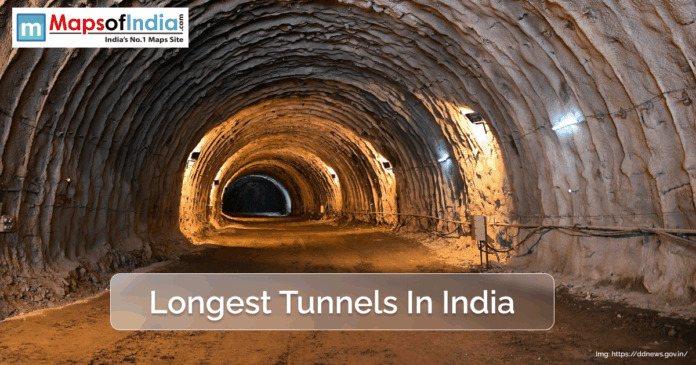India is blessed with a rich tradition of Tunnel construction, as India started constructing tunnels in ancient age. India boasts a variety of tunnel infrastructure, such as roads, railways, water, irrigation, and defence. Jammu and Kashmir‘s Pir Panjal Railway Tunnel is the longest in the nation, measuring 11.215 kilometres.
Connecting the road from Sonmarg to Srinagar, an arm of the National Highway passing through this Z-Morh tunnel will be open in all weather for smooth travel which was virtually impossible in winter till now, whenever snow used to be on the ground, with the Northern way passing through it.
But did you know there are numerous lengths of tunnels that rank into the list of some of the longest tunnels in India and also the most strategically important tunnels in the country? the tallest Atal Tunnel (Himachal Pradesh) powered the world’s longest highway tunnel located height of above 10,000 feet.
Than the aforementioned tunnel, there are many more long tunnels in India including the Chenani-Nashri Tunnel which features in the list of longest tunnels in India.
This article dives into the 10 longest tunnels in India and how they act as milestones in increasing connectivity and movement of goods or services across the different areas of the country.
The Longest Tunnels in India: A List
Read on for the list of longest tunnels in India, extraordinary engineering marvels that not only traverse diverse destinations but also ensure smooth transportation over difficult terrains.
Pir Panjal Railway Tunnel
The longest railway tunnel in India, the Pir Panjal Railway Tunnel (or Banihal-Qazigund Railway Tunnel) is approximately 11.21 kilometres long. The tunnel is a single 8.4 m diameter tube. It is also called T-80, and it is the longest transport tunnel in India.
It was constructed from November 2005 to June 2013. This tunnel is a great engineering marvel situated in the tough territory of the Pir Panjal range in the state of Jammu and Kashmir. It is an important bridge of the Udhampur-Srinagar-Baramulla rail link project, that helps to improve accessibility to the Kashmir Valley. This railway tunnel is meant for broad gauge railways and will run 440 meters below the existing Jawahar Tunnel which often becomes non-functional in winter due to heavy snowfall.
The Pir Panjal Tunnel is an all-weather route for trains and will reduce travel time and improve access to the region. It was built using cutting-edge methods including the New Austrian Tunnel Method (NATM) to make it safer and able to withstand geological challenges. Travel time between Banihal in Jammu and Qazigund in Kashmir has also been reduced by 50 minutes and around Rs 10 lakh per day in fuel consumption has been saved.
Syama Prasad Mookerjee Tunnel
Jammu and Kashmir’s Syama Prasad Mookerjee Tunnel, or the Chenani-Nashri Tunnel, is the fifth longest road tunnel in India. The 9.2-km tunnel was opened to traffic in April 2017.
Jammu and Kashmir’s Zojila pass also faces severe weather, where this road tunnel helps connect Jammu and Srinagar during winters (until snow blocks the existing routes) is the longest road tunnel in India. Built as part of the Chenani-Nashri Road Project, this tunnel drastically cuts down travel time between the two cities, as it avoids the risky mountainous terrain.
Safety Systems: Equipped with state-of-the-art systems for fire detection, ventilation, and emergency exits to protect travellers.
Trivandrum Port Tunnel
It is India’s longest tunnel and the longest tunnel in the world, made from rock with the specific purpose of serving as a divider for vehicular traffic in the most dense urban area of the area of Trivandrum.
The road tunnel, which is about 9 km long, opened in 2022. It is a vital artery for commercial traffic moving to and from the port. The aim of this project was to eliminate a lot of traffic on the current highways and to have an efficient road for heavy vehicles. The advanced engineering practices adopted in the design of the Trivandrum Port Tunnel will ensure its longevity and safety for the users.
This makes it an indispensable asset in the economic development of Kerala, with its advanced lighting systems, ventilation mechanisms, and emergency response features.
Atal Tunnel
Located in Himachal Pradesh, the Atal Tunnel is an engineering marvel that measures around 9 km. Officially opened in October 2020, this road tunnel links Manali with the Lahaul-Spiti Valley and forms a key part of enabling all-weather access to this remote area. It is among the highest tunnels in the world, named after former Prime Minister Atal Bihari Vajpayee.
Built 3,000 metres above sea level, the Atal Tunnel improves connectivity and reduces travel time between Manali and Lahaul-Spiti in the winter months. First, this tunnel has the latest safety measures including fire detection systems, emergency exits, and robust ventilation systems.
Banihal Qazigund Road Tunnel
The Banihal Qazigund Road Tunnel in the Union Territory of Jammu and Kashmir is around 8.5 kilometres in length and was made open for public use in 2021.
The road tunnel is a vital connectivity for Banihal-Qazigund and the region’s rugged area. This tunnel has been constructed to provide all-weather connectivity to vehicular traffic ensuring minimal disruptions during heavy snowfall in winter months. Advances in engineering have been combined in this state-of-the-art tunnel for Banihal Qazigund Road including efficient drainage and safety features.
Sangaldan Railway Tunnel
Built-in 2017, the 7.1-kilometre Sangaldan Railway Tunnel, the longest of its kind in India, is located in the Udhampur-Srinagar-Baramulla rail link project in Jammu and Kashmir.
This railway tunnel is a key component for improving train connectivity in the difficult mountain terrain. The Sangaldan Railway Tunnel, built with the deep subaltern features of the rugged Himalayan terrain in mind, enables remote places to run access and a safe Transit for trains throughout the year.
Rapuru Tunnel
Rapuru Tunnel (Approx. 6.64 Kms) in Andhra Pradesh. This tunnel makes it possible to provide train services in such a challenging terrain as the mountains are crossed directly, making it easier and more convenient for the people of the region.
With modern engineering practices in mind, Rapuru Tunnel is equipped with vital precautions for passenger safety while in transit, ventilation systems and emergency exits.
Karbude Tunnel
Karbude Tunnel, Maharashtra; the 6.5-km Karbude Tunnel was completed in 1997.
The rail overpass is critical to train operations through Maharashtra’s mountainous terrain.
The Karbude Tunnel improves connectivity using advanced engineering techniques appropriate for the area’s terrain while also providing safe transport for people and goods.
Natuwadi Tunnel
The Natuwadi Tunnel, similarly placed in Maharashtra, is about 4.8 kilometres long and came to completion in 1963. This railway tunnel is the most important link in the Maharashtra railway network.
The Natuwadi Tunnel, designed to cut across hilly landscapes, has greatly contributed to train service in the area since its launch. Its structure was built using the modern methods of its times enabling trains to traverse through difficult landscapes safely.





